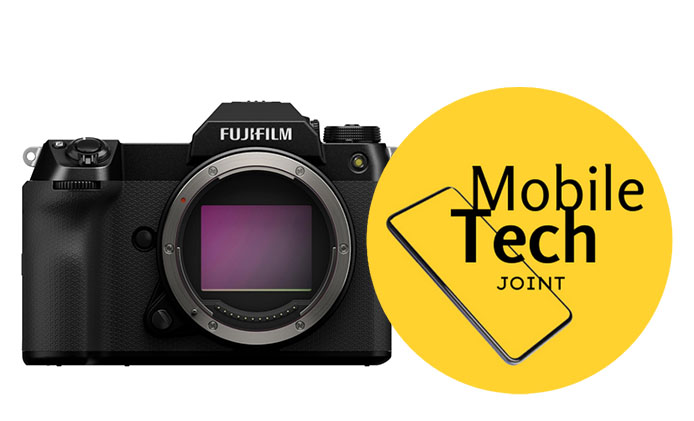Medium format photography has been revolutionized with the introduction of the Fujifilm GFX 100S II. This powerhouse camera combines the best of Fujifilm’s innovative technology with the unparalleled image quality of medium format sensors. In this comprehensive review, we’ll dive deep into the features, performance, and real-world applications of the GFX 100S II, exploring why it’s becoming the go-to choice for professionals and serious enthusiasts alike.

Key Takeaways:
- 100-megapixel medium format sensor for unrivaled image quality
- Improved autofocus system with advanced subject detection
- 8-stop in-body image stabilization (IBIS)
- Compact and weather-sealed body design
- Enhanced video capabilities up to 4K/30p
- New film simulation modes for creative expression
Fujifilm GFX 100S II Review
The Fujifilm GFX 100S II retains the compact and ergonomic design of its predecessor, making it one of the most portable medium format cameras on the market. At just 2.27 pounds (1.03 kg), it’s comparable in weight to many full-frame DSLRs, yet packs a significantly larger sensor.
Key Features:
- Weatherproof construction
- Intuitive control layout with customizable buttons
- 2-inch tilting touchscreen LCD (2.36 million dots)
- High-resolution OLED EVF (5.76 million dots)
- Dual UHS-II SD card slots
The camera’s body features a new textured rubber coating that enhances grip and gives it a premium feel. The top LCD panel, a hallmark of Fujifilm’s professional cameras, provides at-a-glance information about camera settings and can be customized to display a virtual dial layout.
Image Quality and Performance
At the heart of the GFX 100S II lies its 102-megapixel medium format sensor, delivering images with exceptional detail, dynamic range, and color accuracy.
Sensor Specifications:
| Feature | Specification |
| Sensor Type | 43.8 x 32.9mm BSI CMOS |
| Effective Pixels | 102 megapixels |
| ISO Range | 80-12,800 (expandable to 50-102,400) |
| Bit Depth | 16-bit RAW (single shot), 14-bit RAW (continuous) |
The larger sensor size allows for a shallower depth of field compared to full-frame cameras, giving photographers more creative control over their images. The GFX 100S II also benefits from Fujifilm’s latest image processing engine, which enables faster processing and improved noise reduction at high ISOs.
Autofocus and Speed
One of the most significant improvements in the GFX 100S II is its autofocus system. Fujifilm has implemented advanced AI-based subject detection algorithms, including:
- Face and eye detection
- Animal detection
- Vehicle detection
The camera can shoot continuously at up to 7 frames per second, which is impressive for a medium format camera. While it may not match the burst speeds of some full-frame sports cameras, it’s more than capable for most professional applications, including portrait and fashion photography.
In-Body Image Stabilization (IBIS)
The GFX 100S II features an improved 5-axis in-body image stabilization system rated for up to 8 stops of shake reduction. This is a game-changer for medium format photography, allowing for handheld shooting in challenging light conditions and opening up new creative possibilities.
Case Study: Landscape Photography
Professional landscape photographer Sarah Chen shares her experience:
“The 8-stop IBIS on the GFX 100S II has transformed my workflow. I can now capture tack-sharp images of waterfalls and forests at slower shutter speeds without always needing a tripod. This flexibility allows me to work faster and more creatively in the field.”
Video Capabilities
While primarily designed for still photography, the GFX 100S II offers robust video features that make it a capable hybrid shooter:
- 4K video recording up to 30fps
- 10-bit 4:2:2 color (internal and external)
- F-Log and F-Log2 profiles for increased dynamic range
- Full HD high-speed recording up to 120fps
These video specifications, combined with the beautiful medium format look, make the GFX 100S II an attractive option for cinematographers and content creators looking to stand out with unique imagery.
Film Simulation Modes
Fujifilm’s renowned film simulation modes are present in the GFX 100S II, including the new Reala Ace mode. These simulations allow photographers to apply classic film looks to their images in-camera, reducing the need for extensive post-processing.
Popular Film Simulation Modes:
- Provia (Standard)
- Velvia (Vivid)
- Astia (Soft)
- Classic Chrome
- Pro Neg Hi
- Pro Neg Std
- Reala Ace (New)
Connectivity and Workflow
The GFX 100S II is designed to integrate seamlessly into professional workflows:
- USB-C port for tethered shooting and fast file transfer
- Wi-Fi and Bluetooth for wireless image transfer and remote control
- Compatibility with Capture One and Adobe Lightroom for streamlined editing
Conclusion
The Fujifilm GFX 100S II represents a significant leap forward in medium format photography. Its combination of high resolution, advanced autofocus, impressive image stabilization, and compact design makes it a versatile tool for a wide range of photographic applications. While it may not be the fastest camera on the market, its image quality and creative potential are unmatched in its class.
For professionals and enthusiasts who demand the utmost in image quality and are willing to invest in a medium format system, the GFX 100S II offers a compelling package that bridges the gap between traditional medium format cameras and more nimble full-frame systems. As medium format technology continues to evolve, cameras like the GFX 100S II are making this once-niche format more accessible and practical for a broader range of photographers.
Also Check:
- Apple Watch Series 10: What to Expect from the Next Big Upgrade
- AirPods 4: What to Expect from Apple’s Next-Gen Wireless Earbuds
- AirPods Max Alternatives: Top Picks for Premium Over-Ear Headphones and Other Premium Headphone Alternatives…
- Galaxy Watch 7 and Ultra Review: Redefining Health Tracking
- iQoo Z9x Review: A Budget 5G Powerhouse with Impressive Battery Life
